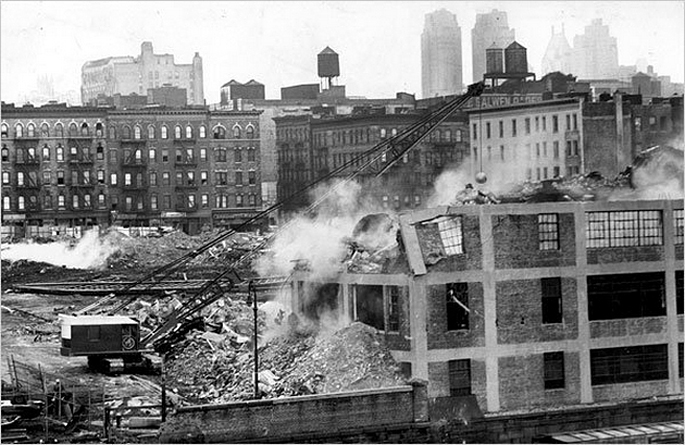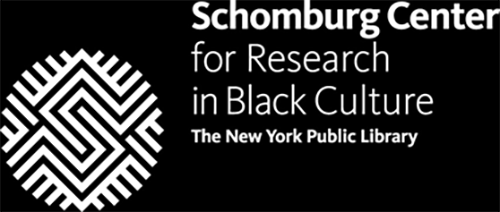In the first half of the twentieth century, the area around where Lincoln Center resides today was known to many as San Juan Hill.
San Juan Hill, and the broader Lincoln Square neighborhood of which it was a part, was a culturally diverse, densely populated, and largely working-class community. It was also a lively cultural center, full of theaters, movie houses, dance halls, schools, and other artist spaces that nurtured luminaries in ragtime, stride, jazz, bebop, mambo and other Afro-Caribbean forms, visual arts, musical theater, and more. Many iconic and influential figures lived there over the years, and their contributions to scholarship, music and art, journalism, social work, and other fields still resonate today.
In the 1950s, the area was targeted for “urban renewal”. The Lincoln Square Development Plan, one of many such programs implemented across the country at the time, displaced more than 7,000 families and 800 businesses, demolished hundreds of buildings, and replaced them with a series of superblocks, including Fordham University, Lincoln Towers, and Lincoln Center for the Performing Arts.
The Legacies of San Juan Hill initiative was created to uplift the complex history, communities, and cultural legacy of this area through artistic programming, commissions, discussions, scholarship, and education. The artists, historians, archivists, journalists, and community members contributing to this project are restoring an important New York story. This digital hub features archival images, articles, video interviews, playlists, recordings of past events, and more. It is a resource that will grow over time.
Lincoln Center is committed to building an inclusive cultural home for all. If you have questions about the media featured on this site or want to share a personal connection to the neighborhood, please email [email protected].
In the first half of the twentieth century, the area around where Lincoln Center resides today was known to many as San Juan Hill.
San Juan Hill, and the broader Lincoln Square neighborhood of which it was a part, was a culturally diverse, densely populated, and largely working-class community. It was also a lively cultural center, full of theaters, movie houses, dance halls, schools, and other artist spaces that nurtured luminaries in ragtime, stride, jazz, bebop, mambo and other Afro-Caribbean forms, visual arts, musical theater, and more. Many iconic and influential figures lived there over the years, and their contributions to scholarship, music and art, journalism, social work, and other fields still resonate today.
In the 1950s, the area was targeted for “urban renewal”. The Lincoln Square Development Plan, one of many such programs implemented across the country at the time, displaced more than 7,000 families and 800 businesses, demolished hundreds of buildings, and replaced them with a series of superblocks, including Fordham University, Lincoln Towers, and Lincoln Center for the Performing Arts.
The Legacies of San Juan Hill initiative was created to uplift the complex history, communities, and cultural legacy of this area through artistic programming, commissions, discussions, scholarship, and education. The artists, historians, archivists, journalists, and community members contributing to this project are restoring an important New York story. This digital hub features archival images, articles, video interviews, playlists, recordings of past events, and more. It is a resource that will grow over time.
Lincoln Center is committed to building an inclusive cultural home for all. If you have questions about the media featured on this site or want to share a personal connection to the neighborhood, please email [email protected].
During the first half of the twentieth century, Lincoln Square was commonly defined as West 57th to 72nd Street, west of Central Park.
San Juan Hill was a distinct neighborhood within Lincoln Square, roughly defined as West 57th Street to West 65th Street, from Amsterdam Avenue to the Hudson River. Neighborhood boundaries are never absolute, and community memory suggests that the name San Juan Hill was actively used throughout the lower 60s west of Columbus Avenue or Broadway.
In the first half of the twentieth century, San Juan Hill and Lincoln Square were home to diverse—and largely segregated—populations, the demographics of which fluctuated over that 50-year period. Read more about the neighborhood demographics in “A History of the Black Community in San Juan Hill: 1900–1915” by Marcy Sacks and “Seeing Lincoln Square” by Samuel Zipp.
During its time, San Juan Hill extended beyond its geographic borders through its cultural contributions and community ties—music and dance, architecture, families, businesses, churches, and more. Its traits and affiliations spilled over the map lines delineated by municipalities. In the years since its disappearance from the Upper West Side, the legacies of San Juan Hill have spread much further—past Amsterdam Avenue, across New York City, and throughout the world.
If you have questions about the media featured on this site or want to share a personal connection to the neighborhood, please email [email protected].
Top image courtesy of: NYC Parks Photo Archive
During the first half of the twentieth century, Lincoln Square was commonly defined as West 57th to 72nd Street, west of Central Park.
San Juan Hill was a distinct neighborhood within Lincoln Square, roughly defined as West 57th Street to West 65th Street, from Amsterdam Avenue to the Hudson River. Neighborhood boundaries are never absolute, and community memory suggests that the name San Juan Hill was actively used throughout the lower 60s west of Columbus Avenue or Broadway.
In the first half of the twentieth century, San Juan Hill and Lincoln Square were home to diverse—and largely segregated—populations, the demographics of which fluctuated over that 50-year period. Read more about the neighborhood demographics in “A History of the Black Community in San Juan Hill: 1900–1915” by Marcy Sacks and “Seeing Lincoln Square” by Samuel Zipp.
During its time, San Juan Hill extended beyond its geographic borders through its cultural contributions and community ties—music and dance, architecture, families, businesses, churches, and more. Its traits and affiliations spilled over the map lines delineated by municipalities. In the years since its disappearance from the Upper West Side, the legacies of San Juan Hill have spread much further—past Amsterdam Avenue, across New York City, and throughout the world.
If you have questions about the media featured on this site or want to share a personal connection to the neighborhood, please email [email protected].
Top image courtesy of: NYC Parks Photo Archive





